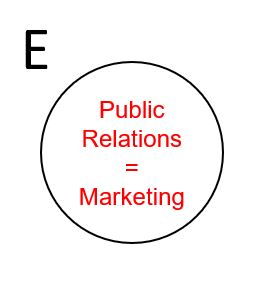PR and Marketing (5): Equals?

To me, this is the strangest, most illogical of the five models. The model describes the merging of Public Relations and Marketing into a single entity. In this model, the two are indistinguishable, at least conceptually. It is difficult to imagine, however, that the outputs of this hybrid would all be as much PR as marketing in nature and vice versa. There are, of course, marketing activities that have PR implications; and PR activities influence business performance so have implications for marketing. Nevertheless, the absolute equalisation of the two seems unfeasible or at least counter-intuitive if we accept the two are different, as older models declare and as certain current applications still suggest is the case.
It is possible that such a model results from the observation of overlaps in the practical effects and enacted processes of these two previously distinct activities, and the consequent death of the need, therefore, to separate them functionally or conceptually. This might reflect big-picture, progressive, integration thinking on the part of management, or the genuine absence of a practical case for separation of the two. Maybe both. The company’s persona, culture, professed ethos, market offerings, ambitions, and strategy may be such that any form of labeling is regarded as a limiting factor so is avoided.
Considering the current socio-technological milieu (described in the article on D-Pub), this model may not be so bizarre after all. In fact, its comprehensibility may be enhanced simply by the removal of the PR-or-Marketing dichotomy. If the terms “Public Relations” and “Marketing [Communications]” were downgraded to component status under a more fitting, relevant, amalgamating term that united the two (and others) but allowed each to be operated independently, might a solution be thereby achieved?
Might that term be “Corporate Communication(s)”?
